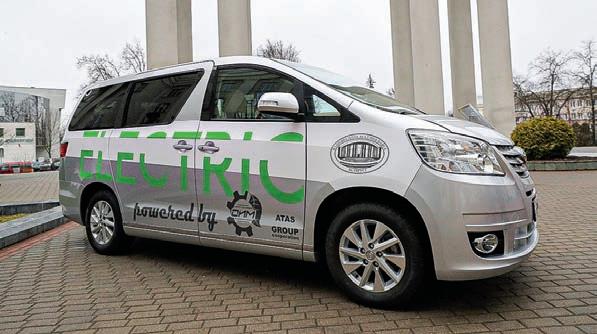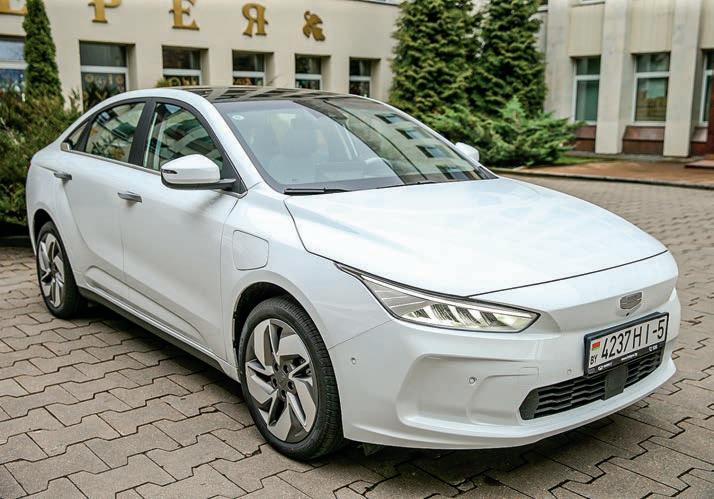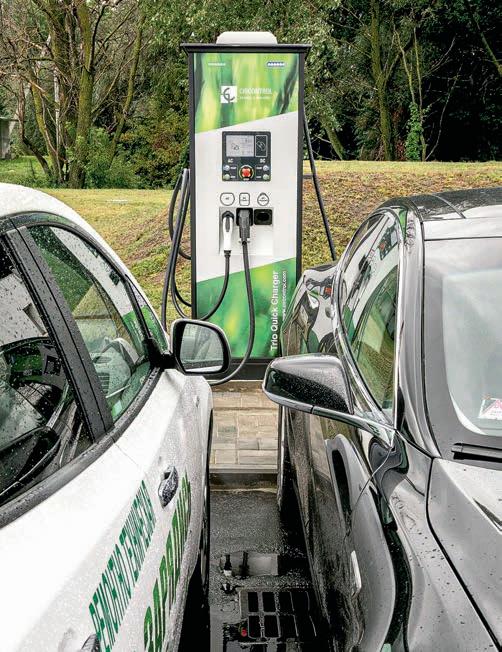
13 minute read
Electro looks attractive
The Decree, signed by the President, “On Encouraging the Use of Electric Motors” is among such measures. The adoption of this document is an im‑ portant condition not o nly for changing the environment for the development of motor transport, but also for creating a completely new reality associated with shaping a new future for Belarus. In particular, it envisages meas‑ ures to stimulate the demand for electric c ars, to create an appropriate charging and service infrastructure in the country.
Under the Decree by the President, owners of electric cars are exempt from paying the duty for a permit to partici‑ pate in road traffic. Individuals will not have to pay VAT when importing elec‑ tric cars for personal use to Belarus. In addition, owners of electric vehicles are exempt from parking fees in specially equipped places in public car parks until January 1, 2026.
Advertisement
In turn, manufacturers of electric cars and electric charging stations, as well as their operating companies, re‑ ceived the right to apply an increased in‑ vestment deduction in accordance with the procedure established by the Tax Code. Charging stations are exempt from VAT if they are used in Belarus. In addition, land plots for construction and maintenance of electric charging complexes will be offered for lease to the Belorusneft production association Electro looks attractive The topic of ecology and respect for nature has received increased attention in Belarus in recent years. Real steps are being taken to address these pressing issues in the country.
ew s . b y
G rodnon
auction free. At the same time, costs for construc‑ tion of charging stations may be transferred free of charge to the balance sheet of the legal entity on which these facilities are registered and included by the customer (developer) in non-operating ex‑ penses. Upon obtaining the consent of the land user, land plots for the operation of charging sta‑ tions will be provided without their withdrawal from public lands.
Transport, non-competitive for the near future
It is obvious that the envisaged measures are advanced. They mean that the country takes into account the trends which will be relevant in 10–15 years. Specialists note that electric transport is non-competitive for the near future. With the de‑ velopment of modern technologies, it is not only economical and environmentally friendly, but also creates conditions for the formation of a radically new infrastructure, i. e . a network of new gas sta‑ tions, electricity transmission systems. With the commissioning of BelAES, the commercialization of the received electricity becomes an urgent issue for Belarus. And one of the key areas is the develop‑ ment of electric transport — both personal, public and freight. It is not for nothing that along with the development of passenger and public electric transport in the U.S., f or example, there are the first samples of electric freight transport, various pick‑ up cars, i. e . business cars. This direction is viewed there as the most future-oriented, because busi‑ ness is always sensitive to the cost of transportation. And the use of electric transport will contribute to cost-effectiveness, therefore business will support the use of electric transport.

Belta
In January, at the exhibition dedicated to the Day of Science, a domestic electric car designed by specialists of the Joint Institute of Mechanical Engineering was presented
◆ Belorusneft PA plans to open 180 fast electric charging stations in 2020. ◆ Today there are 251 fast electric charging stations (FES) in Belarus. ◆ There are 1.4 electric charging stations per each electric car in the country. Specifics
By the way, it pays to remember that the first car in human history was electric. And for mod‑ ern Belarus, taking into account the forthcom‑ ing launch of the nuclear power plant and the situation with energy resources, the new decree is a very far- sighted decision that meets the general development strategy. And it can further improve the image of Belarus in the international arena. Suffice it to recall the Paris Climate Agreement on the reduction of greenhouse gas emissions, which we signed in 2015. Forming an ecologically clean country in the center of Europe is the formation of an entirely new ideology of life. In a word, the adopted decree is a productive decision that will have a good impact on the well-being of people and their health. The future belongs to electric cars, there is no doubt about it. It is a platform for the future development of Belarus.
Choice determines practicability
Yes, the topic of the development of electric transport in the country has recently received a noticeable impetus. —It is not just a tribute to fashion or a desire to keep up with advanced countries, although it is true. It is an urgent necessity today, — the President of Belarus stressed at a recent meeting with the leadership of the Council of Ministers.— Coun‑ tries like us, which are export-oriented, do not have huge underground natural reserves, have long fo‑ cused on electric transport. And it’s only right for us to do it. One of these days we are going to put into service two nuclear power plant units. So why don’t we focus on electric transport, on larger electric‑ ity consumption today, having cushion time? It’s a substitute for hydrocarbons.
Alexander Lukashenko remarked that he had personally tested such novelties: — N ot to show up in a car or to show off a new car. No, I wanted to push you and the entire society to be guided by it.
The President also recalled the instruction to the National Academy of Sciences to create
Belta

In March, Belarus hosted a presentation of the electric car "Geely"
Specialists note that electric transport is non-competitive for the near future. With the development of modern technologies, it is not only economical and environmentally friendly, but also creates conditions for the formation of a radically new infrastructure, i.e. a network of new gas stations, electricity transmission systems.
a domestic electric car. As for the encouragement of the use of electric transport, the head of state drew attention to the following: — Th e task that stems from the construction of the nuclear power plant is to make electric energy for cars cheaper than gasoline and diesel fuel. Then people will start buying electric cars.
Not long ago BELGEE company in Belarus showed Chinese electric cars. There were four of them in total. The Belarusian branch of the Chinese car giant has nothing to do with their creation. At least, not yet. According to the director of the car plant Gennady Svidersky, the novelties arrived to test and study demand: —Our task is to test electric cars from technical and commercial points of view in order to make a decision on further stages of development of this trend at our plant. We need to conduct comprehen‑ sive operational tests, i.e. whether the consumer is satisfied with such a car, whether it is competi‑ tive in the market or not.
New electric cars consume on average 13.5 watthours per 100 km of travel. They have a power reserve of 500 km. They have an adaptive cruise control system, pedestrian and bicycle response systems and an intelligent automatic parking sys‑ tem. As for the possible price for these electric cars in the country, according to Gennady Svider‑ sky, it is too early to speak about a definite figure: —We need to see the cost of the car and the mar‑ ket environment. In addition, when importing an e lectric car in Belarus, one has to pay customs duty, VAT and utilization fee — all this leads to higher prices. Therefore, for mainstream use of electric cars, more comfortable conditions should be created, and the relevant draft documents are being prepared.
One of the arrived electric cars will be tested at the plant in Borisov, while three others will go to the dealership centers. However, it is not unlikely that their assembly will also take place in the coun‑ try. But for this to happen, several factors have to come together. — From the point of view of the strategy, if there is a mass demand — about 10,000 cars a year, it would be advisable to start production. Even 5,000 electric cars would probably be enough for us to make a positive decision.
Another important factor is export markets. BELGEE supplies cars to the markets of Belarus and Russia, negotiations are underway with Ka‑ zakhstan, Uzbekistan and other countries. Electric cars are also in demand in the European market. In the meantime, the company expects a full re‑ sumption of supplies of components from China to produce the cars. The situation with the spread of coronavirus has made some amendments to the work. The situation at the factory in Borisov is nor‑ mal. Out of 1,500 employees only 20 are specialists from China. They were on vacation with the rest of the staff in December and did not visit the country when the coronavirus epidemic broke out in China.
Time affects decision making
In recent years, Belarus has been actively mas‑ tering such technical novelties as electric and un‑ manned cars. For example, the head of the National Foreign Ministry Vladimir Makei stated that Bela‑ rus was negotiating with the companies from Ger‑ many and the USA on transferring the production of electric cars to our country.
“We have contacted an American company, we are working with German companies regarding the possibility of setting up the production here, i.e. in our free economic zones or in the ChinaBelarus Industrial Park,” noted Vladimir Makei.
Belarusian mass media have also joined the trend. Recently they have started actively publish‑ ing reviews of electric cars produced both domesti‑ cally and abroad. And, of course, this topic is under personal control of Alexander Lukashenko — it was on his instruction that the National Academy of Sciences was working out the state program of electric transport development.
Why are electric cars so popular?
We will try to answer the question why the topic of elec‑ tric traction cars is dealt with at the government level. In fact, the most logical reason is the future commissioning of Be‑ lAES.The surplus of electricity will have to be used, so the is‑ sue of domestic electric car production, as well as promotion of their demand in Belarus, was raised.
It is worth noting the main advantages of electric cars: —En vironmental friendliness. Such cars do not use fuel based on petroleum products, so there is no toxic emis‑ sions into the atmosphere. —Safety. Compared to classic cars, the fire and explosion risk is significantly lower. —Cost-effectiveness. Gasoline and diesel are more expen‑ sive than electricity, so the savings to the car owner are obvious. —Low noise level due to fewer moving parts.
Prospects for electric cars in Belarus
It’s necessary to say that the prospects are very, very good. According to optimistic forecasts, by 2025 the number of elec‑ tric cars in the country will reach 32 thousand, and accord‑ ing to pessimistic forecasts — 10 thousand. But even for the second option it is planned to allocate almost $70 million as subsidies for the purchase of these vehicles.
Such a large number of electric cars will also require an extensive network of charging stations, which still cause a certain problem. There are few places for charging electric cars even in Minsk, not to mention highways and regional cities. Belorusneft is mainly engaged in installation of such stations. As mentioned above, the company has quite ambi‑ tious plans. By the way, good news for the owners of such c ars — now all the stations are working in test mode and recharging is free.
The fact that Belarus is trying to establish production of its own electric cars also tells about the serious attitude of the government. But it’s not clear when the Belarusian electric car will go on sale.
In line with the global trend
The first electric car was created before combustion en‑ gines were invented. It was designed in 1841 and looked like a trolley. Interestingly, according to the International Energy Agency, the number of electric cars in the world exceeded the 1912 level only in November 2011. However, within a century and a half electric cars have managed to become a truly perfect and reliable means of transport.
Modern electric cars have several obvious advantages. The key issue for the urban environment is eco-friendliness. The production and maintenance of electric cars consumes sig‑ nificantly less natural resources, even taking into account the o peration of power plants. There is also a second advantage: electric transport is many times more efficient. For example, an electric car converts about 60% of electric energy into me‑ chanical energy, while a gasoline car uses fuel with an efficiency o f 17–20%. This is one of the reasons why the cost of energy to cover the same distance will be lower if an electric vehicle is used.

Belta

Charging time for electric cars is about 6 hours on average
The production and maintenance of electric cars consumes significantly less natural resources, even taking into account the operation of power plants.
When it comes to convenience, it is worth reminding that an electric car does not require gear shifting. Only the steer‑ ing wheel and two pedals are enough to drive such vehicles. In countries with developed electric transport industry, servic‑ ing of electric cars is much cheaper than cars with an internal combustion engine, and service centers are visited on aver‑ age 3–4 times less often. And in case of an accident, nothing can explode or catch fire in an electric car. Last but not the least in importance advantage is quiet work of the engine that creates additional comfort at movement.
But there are also disadvantages. Perhaps, the most sig‑ nificant of them is a trip distance on one charge. In modern electric cars, this problem has been partially solved. For ex‑ ample, Tesla Model S goes 270 miles (494 km) without a re‑ charge, while for most other models the maximum distance does not exceed 300 km. In addition, Tesla super - fast charges will charge 80% the car’s battery within half an hour.
However, the battery chargers are not installed everywhere. If you can drive between states in America without worrying about the recharge, we may have this problem.
A few years ago at the All-Belarus meeting Alexander Lukashenko spoke about the plans to switch to electric transport: “Look at America where there are lines to buy electric cars”. According to the President, there are not many oil and gas deposits in our country, so it is necessary to fo‑ cus on electricity, which will be quite abundant when the AES is launched. At the same time the plans to create their own production of electric cars at the BelGee plant were discussed.
The National Program for Development of Charging In‑ frastructure and Electric Transport provides for the rapid development of a network of charging stations in Belarus. Now it’s clear who is going to be involved in it. According to the decree, Belorusneft will be the state operator to create and develop a network of charging stations for electric cars.
Sales promotion and development of the electric transport branch works in other countries, so it shows what can expect us in the future. For example, in the UK, in order to increase the number of “green” cars, the government provides the Brit‑ ish with a grant to purchase an electric car at the rate of 35% of the car cost and exempts from property tax. In France, the government compensates €10 thousand to the buyers of such cars. These countries have already announced the transition to electric cars by 2040. By that time, there will be a ban on cars with internal combustion engine. The Netherlands is going to switch to electric cars by 2025. Instead of the government, people are encouraged to buy electric cars by local authorities. Purchasers of electric cars are exempt from registration and property taxes. Germany has introduced the following incen‑ tives for buying electric cars, i.e . a 10 year exemption from property tax, a €4000 grant for buying a green car and low in‑ terest on the loan.
The leader in it is Norway. Every third car in the country is electric. Environmental cars are exempt from 25% VAT and car tax, and the owner of an electric car pays a lower road tax. In 2025, Norway will limit carbon dioxide emissions from cars to 0%, thus prohibiting cars with an internal combustion engines.
India and China have also announced the switch to electric cars. In India it is explained by the high level of air pollution. According to Greenpeace, 2.3 million people die annually in the country because of emissions. India plans to ban the sale of new cars on gasoline and diesel by 2030. The government in‑ tends to subsidise the purchase of electric cars for two or three years until cars become affordable.
According to Bloomberg New Energy Finance, electric cars will be cheaper than ordinary cars in ten years, Now the battery accounts for about half of the cost of an electric car. By 2030, the cost of the battery will fall by about 70%. In eight years, the price for “green” cars will be the same as the price for cars on gasoline and diesel. In 2030, electric cars will be 10–20% cheaper and continue to fall in price. And according to Bloomberg NEF analysts, by 2040 in the market of new cars electric cars will make up more than half. By Vasily Tikhomirov







